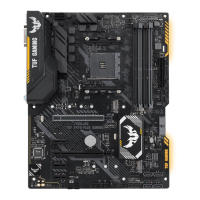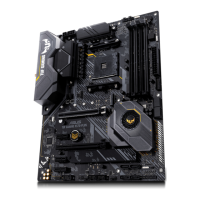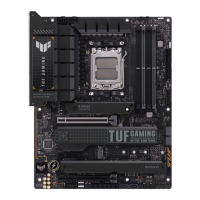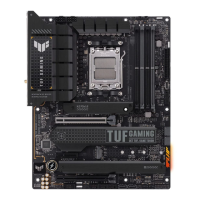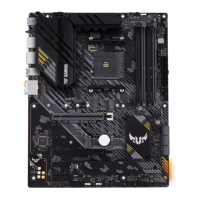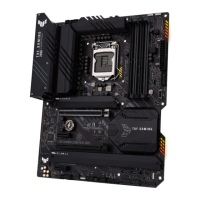Do you have a question about the Asus TUF X299 MARK 1 and is the answer not in the manual?
Provides an overview of the motherboard and its features, including switches and connectors.
Details the physical layout of the motherboard and labels various connectors and components.
Explains the CPU socket and installation precautions for the Intel LGA 2066 socket.
Covers DDR4 DIMM slots, memory configurations, and installation guidelines for CPUs.
Details the PCIe slots on the motherboard and their configurations based on CPU lanes.
Describes onboard buttons like MemOK! and power-on button, and their functions.
Explains the function of jumpers like Clear RTC RAM and CPU Over Voltage jumper.
Details the POST State LEDs and Standby Power LED on the motherboard.
Describes various internal connectors like SATA, USB, fan headers, and power connectors.
Guides through the steps of installing the motherboard and essential components into the PC chassis.
Details the USB BIOS Flashback utility for updating the motherboard BIOS.
Explains rear panel connectors, LAN port LEDs, and audio I/O connections.
Guides on the initial startup process, including power connections and BIOS beep codes.
Instructions on how to properly turn off the computer system.
Introduces the ASUS UEFI BIOS and its features, explaining basic concepts.
Explains how to enter BIOS setup, navigation keys, and modes like EZ Mode and Advanced Mode.
Describes the personal space for saving and accessing favorite BIOS items.
Overview of the Main menu in Advanced Mode, system information, and settings.
Covers overclocking-related settings, including CPU tuning and DRAM frequency.
Details advanced settings for CPU, Platform Misc, System Agent, PCH, and onboard devices.
Displays system temperature, power status, and allows fan settings configuration.
Covers system boot options like Fast Boot, CSM, and boot device control.
Configures options for special functions like EZ Flash 3, Secure Erase, and Overclocking Profile.
Allows loading default values, saving or discarding changes, and exiting the BIOS setup.
Provides information on updating the BIOS using utilities like EZ Update and EZ Flash 3.
Explains Intel Rapid Storage Technology with RAID 0, 1, 5, and 10 solutions.
Details how to create a RAID driver disk for Windows OS installation.
Contains FCC, Industry Canada, and other regulatory compliance statements.
Provides contact details for ASUS technical support in various regions.
| Memory voltage | - V |
|---|---|
| Memory slots type | DIMM |
| Number of memory slots | 8 |
| Supported memory types | DDR4-SDRAM |
| Maximum internal memory | 128 GB |
| Supported memory clock speeds | 2133, 2400, 2666, 3600, 4000, 4133 MHz |
| Component for | PC |
| Motherboard chipset | Intel® X299 |
| Audio output channels | - channels |
| Motherboard form factor | ATX |
| Motherboard chipset family | Intel |
| Drivers included | Yes |
| BIOS type | UEFI AMI |
| ACPI version | 6.0 |
| BIOS memory size | 128 Mbit |
| Processor socket | LGA 2066 (Socket R4) |
| Compatible processor series | Intel® Core™ X-series |
| Graphics card family | AMD, NVIDIA |
| Parallel processing technology support | 2-Way SLI, 3-Way CrossFireX, 3-Way SLI, Quad-GPU CrossFireX, Quad-GPU SLI |
| USB 2.0 connectors | 6 |
| USB 3.2 Gen 2 (3.1 Gen 2) connectors | 3 |
| RAID levels | 0, 1, 5, 10 |
| Ethernet interface type | Gigabit Ethernet |
| eSATA ports quantity | - |
| USB 2.0 ports quantity | 4 |
| Ethernet LAN (RJ-45) ports | 2 |
| USB 3.2 Gen 1 (3.1 Gen 1) Type-A ports quantity | 0 |
| Depth | 244 mm |
|---|---|
| Width | 305 mm |



